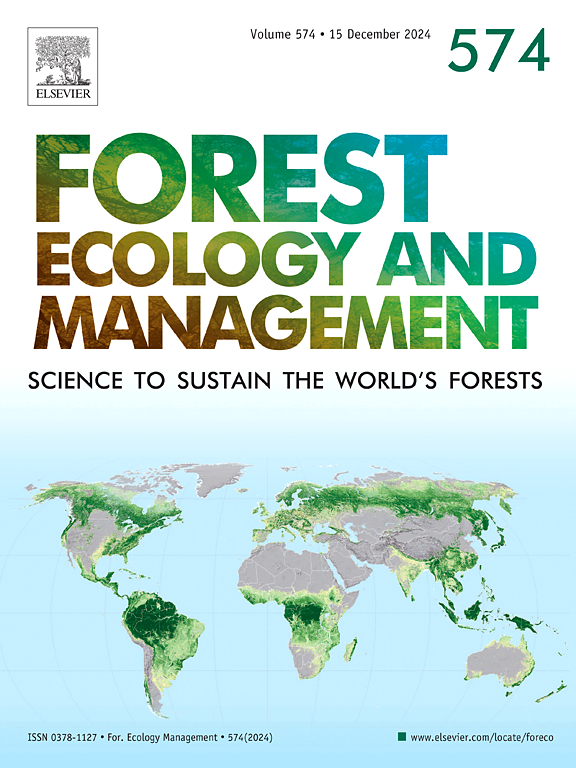Fire and salvage logging increased recalcitrant soil organic matter and reduced soil functionality in Mediterranean pine forests.
IF 3.7
2区 农林科学
Q1 FORESTRY
引用次数: 0
Abstract
Postfire management actions are used to mitigate damage caused by wildfires. Salvage logging, often employed to restore ecosystem functions in burnt stands, plays an essential role in reducing economic losses and the burn severity of future wildfires. However, its ecological implications for soil functionality still need to be understood, especially in the Mediterranean basin, which is prone to erosion and desertification. This study aimed to investigate the effects of fire on (i) soil organic matter (SOM) quality and composition using differential scanning calorimetry-thermogravimetry (DSC-TG) and solid-state nuclear magnetic resonance (13C CPMAS NMR) and (ii) phosphorus (P) forms using solid-state 31P NMR spectroscopy in a wildfire that affected 3200 ha in southeastern Spain in July 2017. One year after the fire, we monitored four Pinus halepensis Mill. stand categories based on soil burn severity (SBS): unburnt, low SBS, high SBS and high SBS areas with salvage logging (n=36, nine plots per SBS level). We collected soil samples and analysed soil pH, SOM content and SOM quality, along with biological activity indicators (carbon biomass, basal respiration, β-glucosidase, phosphatase activities) and P forms. We ran ANOVA statistical tests to identify significant differences in soil properties among SBS levels. We also established general linear regressions of thermo-recalcitrance values and aromaticity with biological soil quality indices to compare both techniques for detecting changes in SOM quality and composition. The results indicated that fire increased soil pH (up to 0.3), particularly in the plots with higher SBS levels. SOM decreased significantly with increasing SBS level (down to < 5 % at the high SBS level), with a shift from labile compounds (carbohydrates) to more recalcitrant ones (aromatics). Organic P forms were depleted, while orthophosphate levels rose, increasing the risk of irreversible fixation. This study also highlights that DSC-TG is a cost-effective technique for assessing SOM quality changes. Understanding these effects is essential for developing policies to conserve and restore fire-affected areas and to promote practices that enhance soil functionality and resilience.
火灾和抢救性砍伐增加了地中海松树林中不易分解的土壤有机质,降低了土壤功能。
火后管理行动用于减轻野火造成的损失。抢救性砍伐通常用于恢复烧毁林分的生态系统功能,在减少经济损失和未来野火的烧毁严重程度方面发挥着至关重要的作用。然而,人们仍需了解其对土壤功能的生态影响,尤其是在易受侵蚀和荒漠化影响的地中海盆地。本研究旨在利用差示扫描量热法(DSC-TG)和固态核磁共振(13C CPMAS NMR)研究火灾对(i) 土壤有机质(SOM)质量和组成的影响,以及(ii) 利用固态 31P NMR 光谱研究火灾对磷(P)形式的影响。火灾发生一年后,我们根据土壤焚烧严重程度(SBS)对四类 Pinus halepensis Mill.林分进行了监测:未焚烧区、低 SBS 区、高 SBS 区和高 SBS 区的抢救性采伐区(n=36,每个 SBS 等级九个地块)。我们采集了土壤样本,分析了土壤 pH 值、SOM 含量和 SOM 质量,以及生物活性指标(碳生物量、基础呼吸、β-葡萄糖苷酶、磷酸酶活性)和 P 形态。我们进行了方差分析统计检验,以确定不同 SBS 水平下土壤特性的显著差异。我们还建立了热重现性值和芳香度与生物土壤质量指数的一般线性回归,以比较这两种检测 SOM 质量和组成变化的技术。结果表明,火灾提高了土壤 pH 值(最高达 0.3),特别是在 SBS 水平较高的地块。随着 SBS 水平的增加,SOM 明显减少(SBS 水平高时减少至 5%),从易腐烂化合物(碳水化合物)转向更难分解的化合物(芳香族化合物)。有机态磷被耗尽,而正磷酸盐水平上升,增加了不可逆固定的风险。这项研究还表明,DSC-TG 是评估 SOM 质量变化的一种经济有效的技术。了解这些影响对于制定受火灾影响地区的保护和恢复政策以及推广提高土壤功能和恢复能力的方法至关重要。
本文章由计算机程序翻译,如有差异,请以英文原文为准。
求助全文
约1分钟内获得全文
求助全文
来源期刊

Forest Ecology and Management
农林科学-林学
CiteScore
7.50
自引率
10.80%
发文量
665
审稿时长
39 days
期刊介绍:
Forest Ecology and Management publishes scientific articles linking forest ecology with forest management, focusing on the application of biological, ecological and social knowledge to the management and conservation of plantations and natural forests. The scope of the journal includes all forest ecosystems of the world.
A peer-review process ensures the quality and international interest of the manuscripts accepted for publication. The journal encourages communication between scientists in disparate fields who share a common interest in ecology and forest management, bridging the gap between research workers and forest managers.
We encourage submission of papers that will have the strongest interest and value to the Journal''s international readership. Some key features of papers with strong interest include:
1. Clear connections between the ecology and management of forests;
2. Novel ideas or approaches to important challenges in forest ecology and management;
3. Studies that address a population of interest beyond the scale of single research sites, Three key points in the design of forest experiments, Forest Ecology and Management 255 (2008) 2022-2023);
4. Review Articles on timely, important topics. Authors are welcome to contact one of the editors to discuss the suitability of a potential review manuscript.
The Journal encourages proposals for special issues examining important areas of forest ecology and management. Potential guest editors should contact any of the Editors to begin discussions about topics, potential papers, and other details.
 求助内容:
求助内容: 应助结果提醒方式:
应助结果提醒方式:


